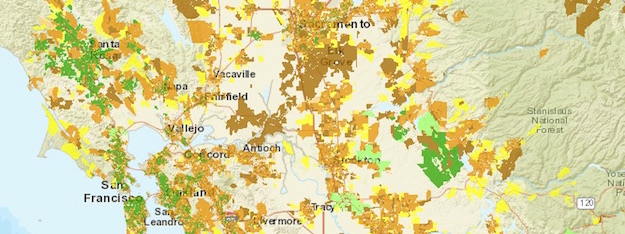
California has a big, new batch of broadband availability data to chew on. The California Public Utilities Commission has updated its broadband availability map with information current as of 31 December 2015. The data is submitted to the CPUC and the Federal Communications Commission by telcos, cable companies, mobile carriers, and some middle mile and fixed wireless operators.
I’m going to be spending a month or two diving into the new data. But after a couple of hours poking around in it, I’m happy to discover that the two biggest telephone companies in California – AT&T and Frontier Communications – have begun providing detailed information on the type of technology that’s deployed in any given census block that they serve – fiber to the premise, VDSL, ADSL or legacy DSL – along with specific upload and download speeds. That greater level of granularity will make for more accurate analysis of primary broadband infrastructure. It’s possible to make a reasonable judgement call as to what kind of technology is present on the basis of speed reports alone, but there’s enough grey area between, say, fast ADSL and slow VDSL to leave room for uncertainty. No longer, though.
Since the data was submitted before Frontier took over Verizon’s wireline business in California this past April, the information about those systems isn’t as good. We’ll have to wait until next year for that.
The cable industry didn’t improve its data reporting practices. Instead of providing census block by census block data about technology deployment and expected service levels, Charter, Comcast and Cox just report the “up to” speeds they advertise pretty much everywhere in the state. Time Warner is a little more granular, but not much. The reports are submitted by census block, but if they’re to be believed, then their service is uniformly excellent everywhere they offer it. That might be okay as a marketing message, but it doesn’t shine the same light on ground conditions or build consumer trust as the telcos’ data does.
The new version of the map also has updated mobile speed test information that’s collected first hand by the CPUC and subjected to rigorous analysis. At first glance, it doesn’t appear that there’s been a huge improvement in availability or performance – for the most part, mobile service fails to meet the CPUC’s minimum standard of 6 Mbps download and 1.5 Mbps upload speeds.
